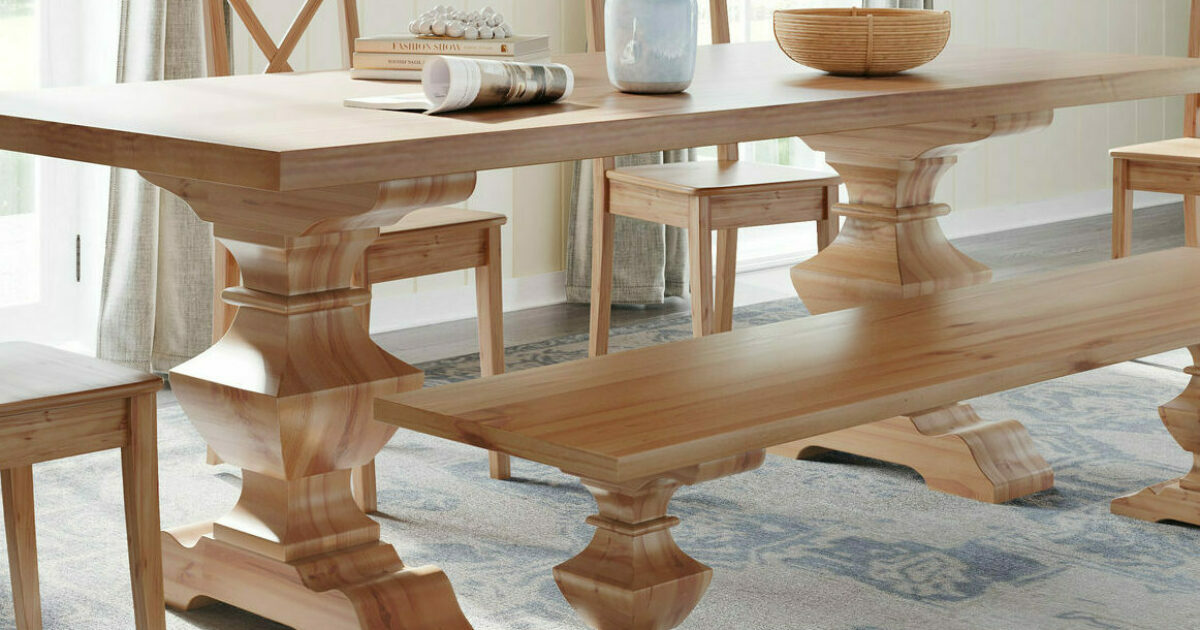Discovering the Different Sorts Of Table Legs Wood for Your Eating Space
The choice of table legs wood can exceptionally affect both the visual and practical top qualities of your eating area. Strong wood options, such as oak and walnut, supply a traditional appearance with unrivaled resilience, while crafted timber options supply ingenious designs that resemble the richness of natural grains. In addition, the growing fad of redeemed wood introduces a lasting component that attract ecologically conscious consumers. As we discover these numerous alternatives, it ends up being important to consider not just the visual charm however additionally the useful ramifications of each product choice. What aspects should assist your choice?
Strong Timber Options

Unlike engineered materials, solid wood is much less prone to bending and damages over time when effectively maintained. Each item of strong timber is special, showcasing private attributes that add to the charm and character of the eating table.
Additionally, strong timber can be ended up in countless means, varying from natural oils to tarnished surfaces, enabling homeowners to personalize their furniture to match their decor. In summary, choosing solid timber for eating table legs not just guarantees architectural stability however also enhances the aesthetic charm of the dining location, making it a beneficial investment for any home.
Engineered Timber Alternatives

Plywood, built from multiple layers of timber veneer, is specifically strong and stable, making it an excellent selection for eating table legs. Its layered composition permits it to stand up to modifications in humidity and temperature far better than standard solid timber. MDF, on the other hand, offers a smooth surface area for painting or veneering, making it possible for designers to accomplish a polished appearance while maintaining structural honesty.
When picking crafted timber alternatives, it is crucial to consider the intended use and wanted visual. These products not just improve the capability of eating rooms but also enable for higher style adaptability, making certain that contemporary and traditional styles can coexist sympathetically.
Reclaimed Timber Includes
Recovered timber supplies an one-of-a-kind mix of sustainability and character, making it an increasingly prominent choice for eating table legs. Sourced from old barns, manufacturing facilities, and other structures, recovered wood symbolizes a history that brand-new products just can not duplicate. Each piece brings its own tale, marked by unique imperfections, knots, and differing grain patterns, which add to a table's special visual appeal.
Along with its visual beauty, redeemed timber is an eco pleasant option. By repurposing formerly made use of products, it minimizes the demand for new lumber, therefore helping to preserve forests and reduce waste. This lines click up with a growing customer choice for lasting practices in furniture.
In addition, redeemed wood is often more durable than recently harvested timber because of its age. The natural drying out process that redeemed wood undertakes results in a denser and more powerful material, making it much less vulnerable to bending and splitting. This enhances the long life of dining tables, allowing them to endure the roughness of everyday usage.
Softwood vs. Hardwood
When picking dining table legs, comprehending the distinctions in between softwood and wood is crucial for accomplishing both functional and aesthetic goals. They typically display an even more rustic look, making them ideal for country-style or informal eating rooms.
On the various other hand, hardwoods, sourced from deciduous trees visit this website like cherry, maple, and oak, are renowned for their density, strength, and sturdiness. The detailed grain patterns and abundant colors of hardwoods provide a classic and advanced charm, making them optimal for formal dining setups. While woods tend to be more expensive and much heavier, their strength against wear and tear typically justifies the investment.
Inevitably, the selection between softwood and wood for special info eating table legs must straighten with your layout vision, use needs, and budget plan, guaranteeing that your dining room mirrors your personal design while staying functional in time.

Surfaces and Therapies
The visual charm and durability of dining table legs can be substantially enhanced with different finishes and treatments. These procedures not just safeguard the wood from damage but also elevate its look, allowing it to match diverse interior styles.
One common therapy is tarnishing, which penetrates the wood and enhances its all-natural grain while including shade. Discolorations supply an abundant, elegant look, enabling home owners to match their furnishings with existing style. Alternatively, clear coatings such as polyurethane or varnish create a protective layer without modifying the wood's original color, making certain longevity versus wear and tear.
Furthermore, natural oils, like tung or linseed oil, nurture the wood and provide a subtle luster, all while being green. These oils permit the surface area to take a breath, avoiding dampness buildup and possible warping.
For those looking for a rustic charm, troubled or weathered surfaces can be put on produce an aged appearance, including character to the item. Ultimately, the option of treatments and surfaces relies on personal choice, desired aesthetic appeals, and the particular timber type, making it important to take into consideration these elements when selecting table legs for your area.
Final Thought
Strong woods, engineered alternatives, and recovered alternatives each offer distinct advantages, catering to various choices and demands. Inevitably, the option of wood type should align with preferred style, resilience, and environmental factors to consider, boosting the general eating experience.
The choice of eating table legs timber can greatly affect both the practical and visual top qualities of your eating area - Dining Table Legs Wood. Solid wood options, such as oak and walnut, provide a classic appearance with unmatched sturdiness, while engineered timber choices supply cutting-edge layouts that imitate the splendor of natural grains. Strong timber uses an ageless high quality that can elevate the overall design of an eating area. Each piece of solid wood is one-of-a-kind, showcasing private qualities that add to the appeal and personality of the dining table
Moreover, recovered wood is typically a lot more sturdy than freshly harvested timber due to its age.